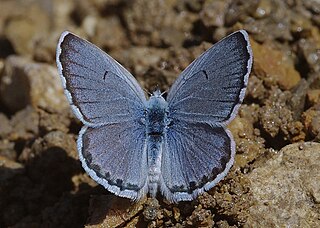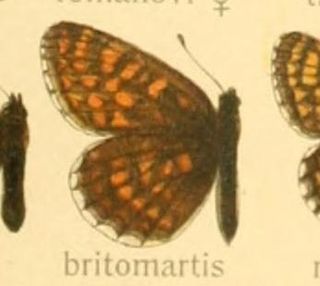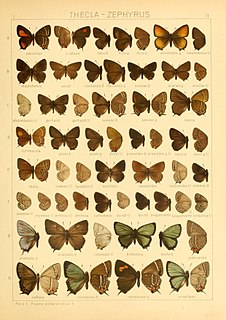
The dark green fritillary is a species of butterfly in the family Nymphalidae. The insect has a wide range in the Palearctic realm - Europe, Morocco, Iran, Siberia, Central Asia, China, Korea, and Japan.

Pseudophilotes vicrama, the eastern baton blue, is a small butterfly found from Asia, east to Tian Shan and parts of China, west to the Balkans, Turkey, eastern Europe to southern Finland. It belongs to the lycaenids or blues family. The species was first described by Frederic Moore in 1865.

The purple-edged copper is a butterfly of the family Lycaenidae.

The scarce large blue is a species of butterfly in the family Lycaenidae. It is found in Austria, Slovenia, Croatia, the Czech Republic, France, Georgia, Germany, Hungary, Italy, Japan, Kazakhstan, Mongolia, the Netherlands, Poland, Romania, Russia, northern Serbia, Spain, Switzerland, and Ukraine and East across the Palearctic to Japan. The species was first described by Johann Andreas Benignus Bergsträsser in 1779.

Diacrisia sannio, the clouded buff, is a moth of the family Erebidae. The species was first described by Carl Linnaeus in his 1758 10th edition of Systema Naturae. It is found in the Palearctic realm from Ireland to Siberia. It is not found in North Africa. In the Russian Far East, eastern China, Korea, and Japan it is replaced by Diacrisia irene.

Calliteara pudibunda, the pale tussock, is a moth of the family Erebidae. The species was first described by Carl Linnaeus in his 1758 10th edition of Systema Naturae. It is found in Europe, Anatolia, Caucasus, western Siberia, eastern Transbaikalia and the Amur basin in south-eastern Russia, Korea, China and northern Vietnam.

Melitaea britomartis, or Assmann's fritillary, is a butterfly in the family Nymphalidae. It has a wide geographic range and is represented by three subspecies.

Photedes captiuncula, the least minor, is a moth of the family Noctuidae. It is found throughout Europe, in Turkey, Armenia, Russia and much of temperate Asia.

Satyrium herzi is a butterfly of the subfamily Lycaeninae. It was described by Johann Heinrich Fixsen in 1887. It is found in the Russian Far East, north-eastern China and Korea.

Satyrium latior is a butterfly of the subfamily Lycaeninae. It was described by Johann Heinrich Fixsen in 1887. It is found in the Russian Far East, northern China and Korea.
Pediasia altaica is a moth in the family Crambidae. It was described by Staudinger in 1899. It is found in Asia, where it has been recorded Sajan, Irkutsk, Amur, Altai, Tannu-Ola, Kentei and Minussinsk.

Ahlbergia frivaldszkyi is a small butterfly found in Russia and the East Palearctic that belongs to the lycaenids or blues family. The larva feeds on Spiraea japonica. It was described by Julius Lederer in 1853.

Antigius butleri is a small butterfly found in the East Palearctic that belongs to the lycaenids or blues family.

Chrysozephyrus brillantinus is a small butterfly found in the East Palearctic that belongs to the lycaenids or blues family.

Pyrgus speyeri is a small butterfly found in the East Palearctic that belongs to the skippers family.

Erebia kindermanni is a butterfly found in the East Palearctic (Altai) that belongs to the browns family. Subspecies E. k. sarytavica Lukhtanov, 1990 is found in South Altai.

Limenitis helmanni is a butterfly found in the East Palearctic that belongs to the browns family.














